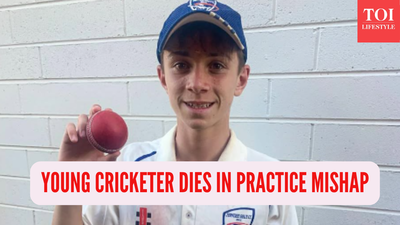A promising young cricket career has come to a sudden and heartbreaking end. On October 30, 2025, a 17-year old cricketer in Melbourne, Ben Austin, tragically lost his life after being struck in the head and neck region by a cricket ball while practicing with an automatic bowling machine. The shocking accident has left teammates, coaches and the people of the cricket community heartbroken. For many, this might just be another unfortunate tragedy, but it has sparked a deeper conversation about how safe practice environments really are, and whether there is enough being done to protect young athletes with better gear and training precautions
The incident
Tragedy occurred at Wally Tew Reserve in Ferntree Gully, where the young athlete was warming up ahead of a local T20 match against Elidon Park. Several media reports indicate that the automatic bowling machine, when delivering the ball, struck the cricketer on his head and neck, despite wearing a helmet. Emergency services rushed him to Monash Medical Centre, but unfortunately, his injuries proved fatal. This heartbreaking event drew immediate comparisons to the tragic death of Australian cricketer Philip Hughes, who succumbed to a similar neck injury-related death, back in 2014, reflecting upon the limitations of current protective equipment.
Types of head and neck injuries that can be fatal

Cricket, while generally a safe sport, carries the risk of severe head and neck injuries. A direct impact from a high-velocity ball can lead to several catastrophic conditions.Epidural Hematoma: This occurs when bleeding accumulates between the skull and brain. Pressure builds rapidly, potentially leading to unconsciousness or death, if not treated immediatelySubdural Hematoma: Bleeding beneath the dura mater (i.e outer protective covering of the brain) can compress brain tissue and disrupt critical neurological functionSubarachnoid Hemorrhage: A kind of ruptured blood vessel on the brain’s surface floods the surrounding space, often causing fatal outcomes without immediate intervention.Diffuse Axonal injury: High-impact trauma that can cause microscopic tears in the brain tissue, resulting in severe neurological damage.Skull fractures with brain penetration: The bone fragments can get punctured or compress the brain, causing irreversible damage.These injuries are especially dangerous, because in these types of injuries there are no evident symptoms that occur immediately, emphasising the importance of rapid medical attention and on-site preparedness. (These findings are mentioned in the Medical Journal of Australia)
Role of protective gear:

Cricket helmets have evolved significantly, yet the gaps remain in its protective coverage. Modern helmet protects the skull and face, but often leave neck and base of the skull exposed. Following the death of Philip Hughes, the use of neck guards was recommended, but adherence is inconsistent, particularly during early practice sessions. This incident underscores the need for mandatory neck guards, especially when using automatic bowling machines to practice, because of its ability to deliver balls at consistent high speeds.
Safety protocols:
Though, practice sessions are less formal than on-field matches, still the risk of injury can be equally severe:
- Practice environments should be periodically assessed for hazards, equipment safety and adherence to the best of practices
- Players and coaches must understand the risk of head or neck injuries
- There should be first aid kits and rapid access to medical transport
- All players, regardless of the age, should wear helmets with integrated neck protection
As the cricket community mourns, it must also learn, so that no other young player’s dream ends this way ever again!
